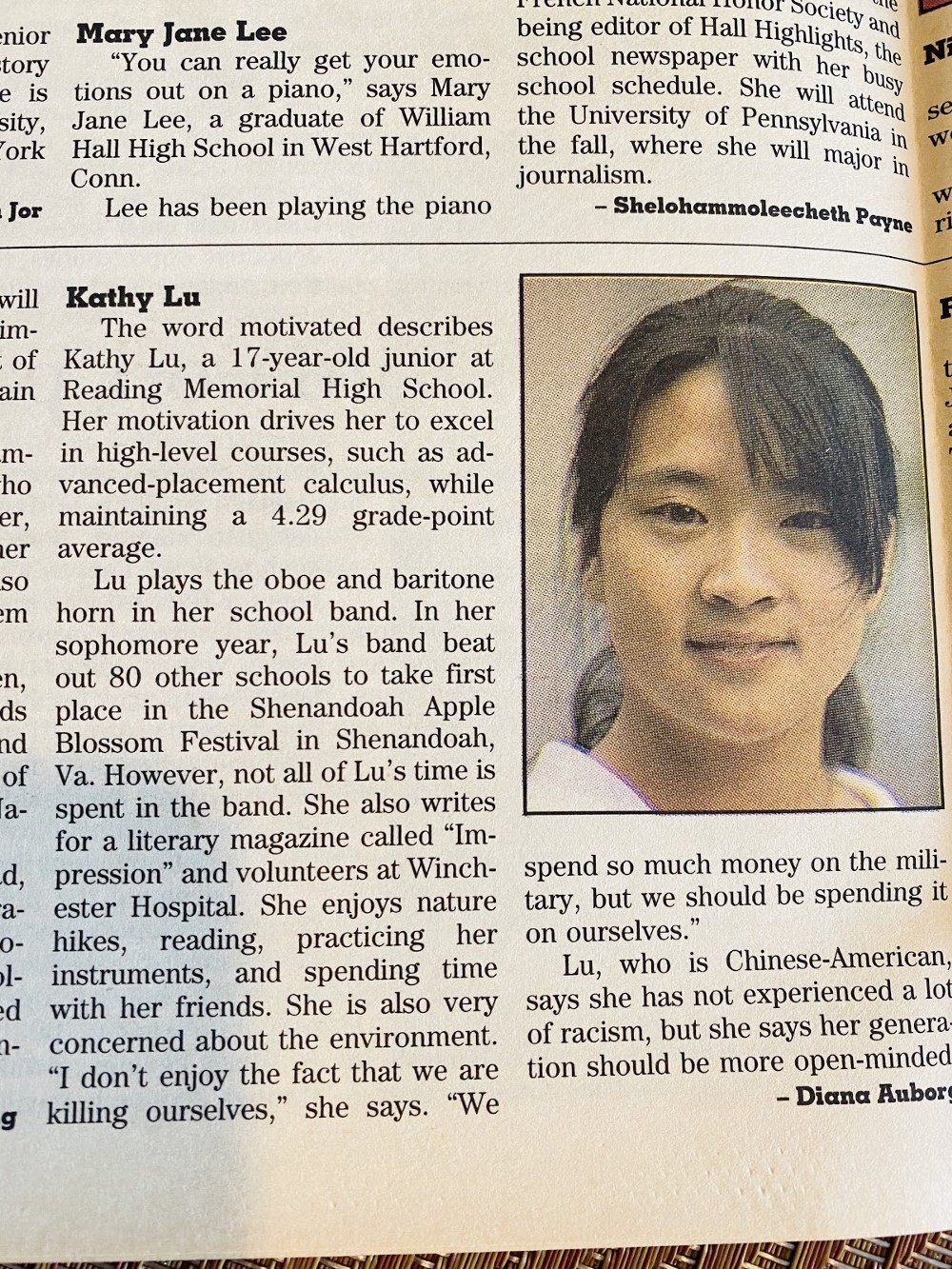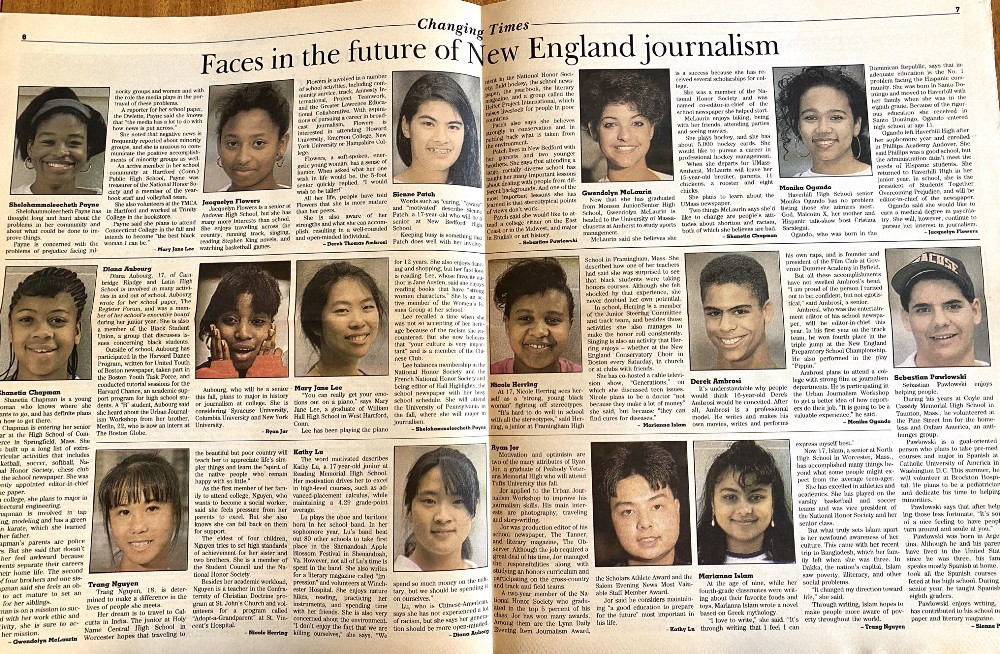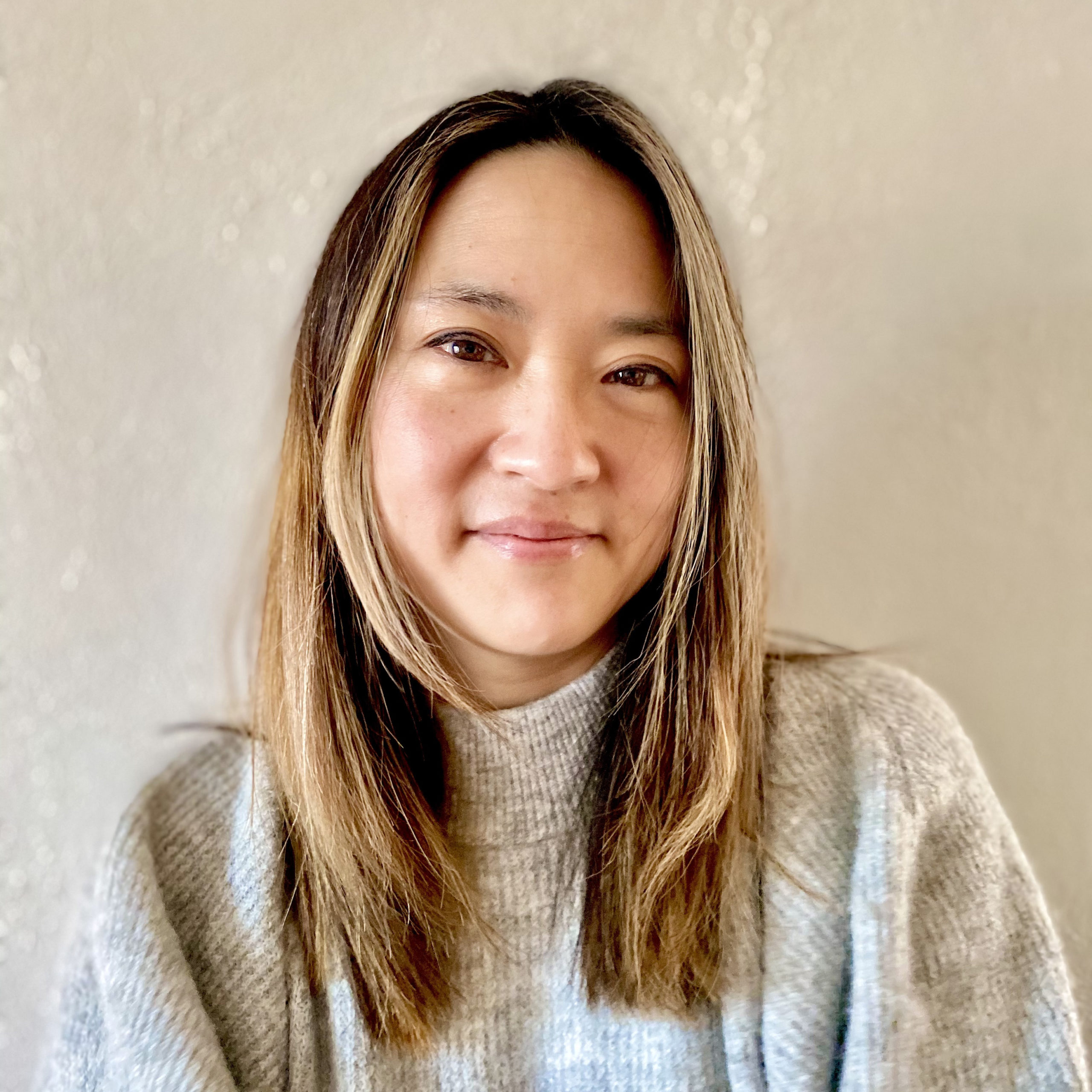Going through boxes of keepsakes recently, I found a copy of Changing Times, a newspaper that I helped produce as part of the 1992 University of Massachusetts at Boston summer Urban Journalism Workshop.
The centerfold features 15 of us, high school minority students from across Massachusetts.
We called ourselves “The Future of New England journalism.” We interviewed one another and wrote up short bios.
What struck me about this forgotten piece of my history is not the photo of me (at 17!), but how Diana Auborg thought to ask me if I’ve experienced racism.
In the short profiles, we asked one another about our cultures, about what we wanted to learn and how we wanted to change the world. Laced within the answers and throughout the 12-page paper was a sense that we, the teens, should expect to join a larger fight against an entrenched white system. (Auborg also wrote a story on the state of minority employment at daily newspapers — a story that still resonates today.)
Decades later, I look at these smiling faces full of promise, this program meant to cultivate diversity for journalism and wonder: How did journalism fail so hard?
What was true in 1968
Another box, another keepsake.
A small book of essays by the former chairman of Landmark Communications, Frank Batten. I used to work at one of Landmark’s papers, The Roanoke Times.
One essay was titled “Minority hiring: a top priority.” It’s dated October 1986. This is how it starts:
In Landmark, we have long worked to demolish racial barriers in our communities. And it was almost 20 years ago when I first addressed Landmark’s executives about our obligation to increase employment of minorities throughout our workforce. I concluded my remarks then with the following paragraph:
“The only way to discharge this obligation is to make up our minds that it is going to be done and that the obstacles are going to be overcome. I think each division should set a goal for itself that will make a substantial improvement in our record when we look at it again next year. It will take courage. It will cost some money and there will be risks. But the alternatives are unacceptable.”
I quote those remarks because they state Landmark’s attitude as well today as they did in 1968.
Yes. 1968.
My turn to lead
Here’s the thing: Journalism has always had the best of intentions. But intent does not equal change.
Essays have been written, programs created, committees formed, but there is always a dam in the flow. Or not enough strength in the current.
And it relies too much on a passionate few — most of whom not in power — to carry the efforts.
I can testify.
The Roanoke Times hosted a summer Minority Journalism Workshop for years, led by JoAnne Poindexter, a paper’s first Black reporter. It was her passion project. She wasn’t paid extra to run the program, which at one point ran for two weeks. And it was so shoestring one year that she told me she made peanut butter and jelly sandwiches to serve as lunch.
By the time I began coordinating the high school workshop with her, the program had a small budget. We took the students on trips and bought lunches.
It was awesome. I felt we gave the students an insider look at their local newspaper. We met their parents and made connections.
I’m so proud that several MJW alumni are now working in newsrooms (Amanda Barrett was recently named deputy managing editor at the Associated Press and check out Shaban Athuman’s work for The Dallas Morning News).
I’m not proud of how toward the end of MJW’s existence, years after Poindexter retired in 2008 and I had taken over, the program couldn’t attract enough students of color. We did not build upon those connections with Roanoke’s communities of color; I did not make those connections throughout the year.
I can say it’s because I didn’t have the time, but really it’s because I didn’t make it a priority. And no one pushed me to do so.
How newsrooms need to change
I began to normalize hearing regular discussions around the diversity dilemma without seeing real changes. At one point, a Landmark leader told the newsroom that diversity was about profit.
This was right before everything crashed, and diversity discussions were soon shelved, a faded memory of the Golden Age.
Where are we now? The ripples from protests against systemic racism after police killed George Floyd have rightly touched newsrooms. On social media, journalists have shared experiences of suppression, racism, sexism and more.
I’m hearing the same discussions about diversity as I’ve heard before: How do we fix this?

A 17-year-old me. Most of what I said is still true! (Kathy Lu)
Here’s what I’ve learned.
If you want to build a newsroom that supports and keeps journalists of color and their allies, you can’t do it with programs and committees alone. And you can’t rely on the passion of a few — even if it’s the chairman of the company, apparently — to bring lasting transformation.
You also can’t rely solely on the ambition of people of color to find a way into the hiring pipeline. I knew I wanted to be a journalist and followed that path. But plenty of journalists never responded to my request for guidance when I was an eager student.
My career is thanks to the Landmark Internship program, which hired college graduates of color to work for a year at the three Landmark papers. During the internship, I was offered a job in Roanoke and took it without having to finish the year.
I’m also an alum of the Maynard Institute Media Academy, the Asian American Journalists Association Executive Leadership Program, and numerous other wonderful training programs. I feel incredibly lucky and privileged for these opportunities. I wish I didn’t.
In the end, I hit the dam, too. I was laid off from The Kansas City Star in 2019, yet another victim of budget cuts.
So, newsrooms, what are you doing?
If you have a program to nurture journalists of color, what is your ultimate goal? It can’t be just to host a program. What kind of follow-up do you do? How many of those people have become employees?
If you have an internal committee, are the members compensated for their time? What power do they have to effect change? A committee needs to be more than checked box on a list of “Newsroom Diversity Efforts.”
If you know you’ve failed at making connections with communities of color, it’s not too late to do it now. But it has to be a priority for every reporter and editor in the newsroom, not just the race and culture reporter. You have to develop a system that allows and rewards discussion about this. You have to be open to criticism, to want to burst that dam and institute a new system.
This current moment has brought a widespread reckoning to journalism that I’ve not seen before. Dear newsrooms: Take advantage of it.
Listen to what your staff is asking; ask how you can do better. People may be angry, but focus on what can happen on the other side of anger: real change.
Newsrooms have been too afraid of the tension these discussions evoke. Don’t be. It’s the pain that comes with true growth.
I promise to ask the questions, to challenge the systems that need to change. Let me know if you’re doing it, too.
Kathy Lu is the digital and social media editor for America Amplified, a 2020 community engagement journalism effort funded by the Corporation for Public Broadcasting. She was formerly an editor at The Kansas City Star and The Roanoke Times. She is based in Kansas City, Missouri. You can reach Kathy at lukathy97@gmail.com.








Hi Kathy. Thank you for your thoughts on diversity in the industry. I was a mentor and board member for the high school journalism program that you participated in at UMass Boston! Carole Remick passed away a few years ago, but the program does actually live on in another format.
It’s currently housed at Regis College and no longer a minority only program. We’ve also branched out beyond Boston and the program is called the New England High School Journalism Collaborative. And I teach in the journalism department at Boston University. I would have been an editor at the Boston Globe when you were in this program. 🙂
I’m so thrilled to see that you went on to do great work in the industry. It makes the work that some of us have been doing for years worth every (mostly) unpaid moment. As you rightly point out, these discussions have been going on for decades and we’re still trying to “fix” the problems.
My hope is that this time it will stick. There does seem to be something different about the discussions this time around.
Kudos to you again and I hope you’ll be open to speaking to next year’s group of students. I’m sure they would be very interested to hear your story.
Michelle Johnson
Associate Professor, Journalism
Boston University